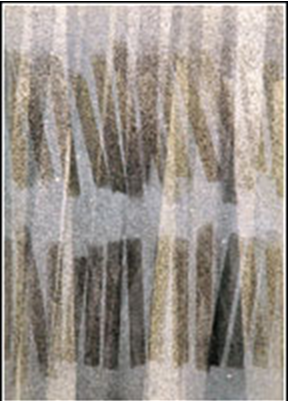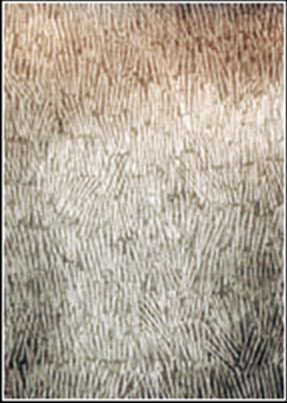Jamil Baloch
This is a collection of articles archived for the excellence of their content. Readers will be able to edit existing articles and post new articles directly |
Jamil Baloch
Reading between the lines
In Jamil Baloch’s latest collection, ingenious and inventive experimentation merges subject and technique to great effect. One is totally absorbed by the bold assurance of the lines transformed from dark into columns of light, writes, Marjorie Husain
A message received from surrealist painter, Mansur Salim, carried Michael Corbin’s profound words on reading of Robert Rauschenberg’s death. “We need to get into the habit of complimenting people while they are alive. Praising me when I am dead does me no good, but a nice comment while I’m alive might actually get me through another day.”
Words to live by.
Mansur Salim is, of course an awesome talent, one with a singular vision that carves out a path of its own. Another free spirit of the art world is Jamil Baloch, whose spectacular diversity is strong and exciting. His recent collection of work displayed at Karachi’s Canvas Gallery has to be absorbed not translated. Ahmed Parvaz once paraphrasing the words of Picasso said: “Paintings are like people — you don’t have to understand them — you just have to love them.” He never said a truer word.
Baloch is an extremely versatile artist, a sculptor equally at ease while painting, drawing and of late, juxtaposing diverse aspects in his work without inhibition. In his latest collection, ingenious and inventive experimentation merges subject and technique to great effect. Baloch attributes his multifaceted gifts to his childhood surroundings in Nushki, Balochistan, where he grew up in a society adept at building homes from wood, welding metals, weaving patterns and creating traditional embroidery. There was also a great zest for life and enjoyment of music and movement, so even now Baloch enjoys making music with the musicians of his home town.
One has delighted in the artist’s liberated imagination since his first group exhibition in Karachi, 2000, when a collection of seven, ten feet tall statuettes garbed in black burqas stole the show. Since Baloch has held several exhibitions of his work in Pakistan and abroad. His work shown in group displays has invariably drawn the viewer into a close perceptual inter-action. His work is inspired by intensely felt personal experience and observation. The impact of the tall burqa clad forms, standing in the grounds of the National Art Gallery, on the occasion of the opening, remained in the minds of visitors long after the exhibition closed. Inside the gallery, a ten by ten feet relief mural that depicts an expanse of desert with a rocket embedded in one corner of the artwork spoke volumes.
The artist’s wall-based relief murals, with winged forms, helmeted men and rockets, seen in exhibition previously held in Karachi, appear to leap out of the metal studded frames. Baloch creates sculpture in any media with facility; metal, wood, stone or clay. As a boy, he loved to make junk sculpture with found objects; it was an instinctive, natural occupation. He still loves to put materials and media together — not as a weighed down solid mass, but with an easy interchange of space.
The latest exhibition at the Canvas Gallery is an outcome of his recent engagement with ‘line’, in a series of superb drawings defined to open the space around them. In no way a prisoner of a particular style or success, like his elder brother, Akram Dost, Baloch works obsessively with the passionate need to express his experience of the world around him. In this latest work, geographical classification is eschewed; the dynamic expression is achieved by interplay between overlapping vertical shapes and shades. There is a continuous textual diversity created by the application of the media and gradient monochrome colouration. He explains that his motivation remains addressed by social-consciousness, here expressed in a complexity of ‘lines.’
As though familiar with the artist’s work know, he has always enjoyed working on a large scale. Early examples are found at the National College of Art, Lahore where he teaches sculpture. At a residency in Colombo some time back, his work had to be left behind as due to the size of his pieces transportation proved difficult.
In the latest exhibition of wall based work, tall paintings stretching from ceiling to floor reverberate with ‘presence’. One is totally absorbed by the bold assurance of the lines transformed from dark into columns of light. The attention to surface regeneration is suggested by tiny, seed like paint deposits. Using strips of plaster on paper and spray paint, Baloch created a total erasure of representative form with work that may be read in countless ways; examining the work in detail and at length, one discovers shapes, movements and forms that appear to have disappeared and left dancing shadows. White streaks suggest clouds, perhaps, or as the artist states, ‘symbols of optimism’.
The work is hugely intriguing, extremely dynamic. It is idealistic because that is the artist’s view of life.

